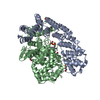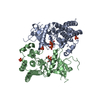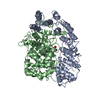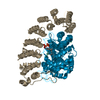+ Open data
Open data
- Basic information
Basic information
| Entry | Database: PDB / ID: 7lto | ||||||
|---|---|---|---|---|---|---|---|
| Title | Nse5-6 complex | ||||||
 Components Components |
| ||||||
 Keywords Keywords |  STRUCTURAL PROTEIN / SMC5/6 / Nse5-6 / Nse5 / Nse6 / STRUCTURAL PROTEIN / SMC5/6 / Nse5-6 / Nse5 / Nse6 /  complex / SUMO-binding complex / SUMO-binding | ||||||
| Function / homology |  Function and homology information Function and homology informationSmc5-Smc6 complex / SUMO is conjugated to E1 (UBA2:SAE1) / SUMOylation of nuclear envelope proteins / SUMO is transferred from E1 to E2 (UBE2I, UBC9) / SUMO is proteolytically processed / SUMOylation of transcription factors / Postmitotic nuclear pore complex (NPC) reformation / SUMOylation of transcription cofactors / SUMOylation of DNA damage response and repair proteins / SUMOylation of DNA replication proteins ...Smc5-Smc6 complex / SUMO is conjugated to E1 (UBA2:SAE1) / SUMOylation of nuclear envelope proteins / SUMO is transferred from E1 to E2 (UBE2I, UBC9) / SUMO is proteolytically processed / SUMOylation of transcription factors / Postmitotic nuclear pore complex (NPC) reformation / SUMOylation of transcription cofactors / SUMOylation of DNA damage response and repair proteins / SUMOylation of DNA replication proteins /  septin ring / SUMOylation of SUMOylation proteins / chromatin looping / Recruitment and ATM-mediated phosphorylation of repair and signaling proteins at DNA double strand breaks / SUMOylation of RNA binding proteins / SUMOylation of chromatin organization proteins / septin ring / SUMOylation of SUMOylation proteins / chromatin looping / Recruitment and ATM-mediated phosphorylation of repair and signaling proteins at DNA double strand breaks / SUMOylation of RNA binding proteins / SUMOylation of chromatin organization proteins /  regulation of telomere maintenance / ubiquitin-like protein ligase binding / protein sumoylation / condensed nuclear chromosome / double-strand break repair via homologous recombination / PML body / regulation of telomere maintenance / ubiquitin-like protein ligase binding / protein sumoylation / condensed nuclear chromosome / double-strand break repair via homologous recombination / PML body /  protein tag activity / protein tag activity /  chromosome, telomeric region / chromosome, telomeric region /  DNA repair / identical protein binding / DNA repair / identical protein binding /  nucleus / nucleus /  cytoplasm cytoplasmSimilarity search - Function | ||||||
| Biological species |   Saccharomyces cerevisiae (brewer's yeast) Saccharomyces cerevisiae (brewer's yeast) | ||||||
| Method |  ELECTRON MICROSCOPY / ELECTRON MICROSCOPY /  single particle reconstruction / single particle reconstruction /  cryo EM / Resolution: 3.2 Å cryo EM / Resolution: 3.2 Å | ||||||
 Authors Authors | Yu, Y. / Li, S.B. / Zheng, S. / Tangy, S. / Koyi, C. / Wan, B.B. / Kung, H.H. / Andrej, S. / Alex, K. / Patel, D.J. / Zhao, X.L. | ||||||
| Funding support |  United States, 1items United States, 1items
| ||||||
 Citation Citation |  Journal: Proc Natl Acad Sci U S A / Year: 2021 Journal: Proc Natl Acad Sci U S A / Year: 2021Title: Integrative analysis reveals unique structural and functional features of the Smc5/6 complex. Authors: You Yu / Shibai Li / Zheng Ser / Tanmoy Sanyal / Koyi Choi / Bingbing Wan / Huihui Kuang / Andrej Sali / Alex Kentsis / Dinshaw J Patel / Xiaolan Zhao /  Abstract: Structural maintenance of chromosomes (SMC) complexes are critical chromatin modulators. In eukaryotes, the cohesin and condensin SMC complexes organize chromatin, while the Smc5/6 complex directly ...Structural maintenance of chromosomes (SMC) complexes are critical chromatin modulators. In eukaryotes, the cohesin and condensin SMC complexes organize chromatin, while the Smc5/6 complex directly regulates DNA replication and repair. The molecular basis for the distinct functions of Smc5/6 is poorly understood. Here, we report an integrative structural study of the budding yeast Smc5/6 holo-complex using electron microscopy, cross-linking mass spectrometry, and computational modeling. We show that the Smc5/6 complex possesses several unique features, while sharing some architectural characteristics with other SMC complexes. In contrast to arm-folded structures of cohesin and condensin, Smc5 and Smc6 arm regions do not fold back on themselves. Instead, these long filamentous regions interact with subunits uniquely acquired by the Smc5/6 complex, namely the Nse2 SUMO ligase and the Nse5/Nse6 subcomplex, with the latter also serving as a linchpin connecting distal parts of the complex. Our 3.0-Å resolution cryoelectron microscopy structure of the Nse5/Nse6 core further reveals a clasped-hand topology and a dimeric interface important for cell growth. Finally, we provide evidence that Nse5/Nse6 uses its SUMO-binding motifs to contribute to Nse2-mediated sumoylation. Collectively, our integrative study identifies distinct structural features of the Smc5/6 complex and functional cooperation among its coevolved unique subunits. | ||||||
| History |
|
- Structure visualization
Structure visualization
| Movie |
 Movie viewer Movie viewer |
|---|---|
| Structure viewer | Molecule:  Molmil Molmil Jmol/JSmol Jmol/JSmol |
- Downloads & links
Downloads & links
- Download
Download
| PDBx/mmCIF format |  7lto.cif.gz 7lto.cif.gz | 130.6 KB | Display |  PDBx/mmCIF format PDBx/mmCIF format |
|---|---|---|---|---|
| PDB format |  pdb7lto.ent.gz pdb7lto.ent.gz | 91.5 KB | Display |  PDB format PDB format |
| PDBx/mmJSON format |  7lto.json.gz 7lto.json.gz | Tree view |  PDBx/mmJSON format PDBx/mmJSON format | |
| Others |  Other downloads Other downloads |
-Validation report
| Arichive directory |  https://data.pdbj.org/pub/pdb/validation_reports/lt/7lto https://data.pdbj.org/pub/pdb/validation_reports/lt/7lto ftp://data.pdbj.org/pub/pdb/validation_reports/lt/7lto ftp://data.pdbj.org/pub/pdb/validation_reports/lt/7lto | HTTPS FTP |
|---|
-Related structure data
| Related structure data |  23517MC M: map data used to model this data C: citing same article ( |
|---|---|
| Similar structure data |
- Links
Links
- Assembly
Assembly
| Deposited unit | 
|
|---|---|
| 1 |
|
- Components
Components
| #1: Protein | Mass: 65276.961 Da / Num. of mol.: 1 Source method: isolated from a genetically manipulated source Source: (gene. exp.)   Saccharomyces cerevisiae (brewer's yeast) Saccharomyces cerevisiae (brewer's yeast)Gene: NSE5, YML023C / Production host:   Escherichia coli BL21(DE3) (bacteria) / References: UniProt: Q03718 Escherichia coli BL21(DE3) (bacteria) / References: UniProt: Q03718 |
|---|---|
| #2: Protein | Mass: 67645.180 Da / Num. of mol.: 1 Source method: isolated from a genetically manipulated source Source: (gene. exp.)   Saccharomyces cerevisiae (brewer's yeast) Saccharomyces cerevisiae (brewer's yeast)Gene: SMT3, YDR510W, D9719.15, KRE29, YER038C / Production host:   Escherichia coli BL21(DE3) (bacteria) / References: UniProt: Q12306, UniProt: P40026 Escherichia coli BL21(DE3) (bacteria) / References: UniProt: Q12306, UniProt: P40026 |
-Experimental details
-Experiment
| Experiment | Method:  ELECTRON MICROSCOPY ELECTRON MICROSCOPY |
|---|---|
| EM experiment | Aggregation state: PARTICLE / 3D reconstruction method:  single particle reconstruction single particle reconstruction |
- Sample preparation
Sample preparation
| Component | Name: Nse5-Nse6 complex / Type: COMPLEX / Entity ID: all / Source: RECOMBINANT |
|---|---|
| Molecular weight | Value: 0.133 MDa / Experimental value: NO |
| Source (natural) | Organism:   Saccharomyces cerevisiae (brewer's yeast) Saccharomyces cerevisiae (brewer's yeast) |
| Source (recombinant) | Organism:   Escherichia coli BL21(DE3) (bacteria) Escherichia coli BL21(DE3) (bacteria) |
| Buffer solution | pH: 7.5 |
| Specimen | Conc.: 0.3 mg/ml / Embedding applied: NO / Shadowing applied: NO / Staining applied : NO / Vitrification applied : NO / Vitrification applied : YES : YES |
| Specimen support | Grid material: GOLD / Grid mesh size: 300 divisions/in. / Grid type: UltrAuFoil R1.2/1.3 |
Vitrification | Cryogen name: ETHANE |
- Electron microscopy imaging
Electron microscopy imaging
| Experimental equipment |  Model: Titan Krios / Image courtesy: FEI Company |
|---|---|
| Microscopy | Model: FEI TITAN KRIOS |
| Electron gun | Electron source : :  FIELD EMISSION GUN / Accelerating voltage: 300 kV / Illumination mode: FLOOD BEAM FIELD EMISSION GUN / Accelerating voltage: 300 kV / Illumination mode: FLOOD BEAM |
| Electron lens | Mode: BRIGHT FIELD Bright-field microscopy / Nominal magnification: 22500 X / Calibrated magnification: 47262 X Bright-field microscopy / Nominal magnification: 22500 X / Calibrated magnification: 47262 X |
| Image recording | Electron dose: 53 e/Å2 / Film or detector model: GATAN K3 (6k x 4k) |
- Processing
Processing
| Software | Name: PHENIX / Version: 1.17.1_3660: / Classification: refinement | ||||||||||||||||||||||||
|---|---|---|---|---|---|---|---|---|---|---|---|---|---|---|---|---|---|---|---|---|---|---|---|---|---|
CTF correction | Type: PHASE FLIPPING AND AMPLITUDE CORRECTION | ||||||||||||||||||||||||
3D reconstruction | Resolution: 3.2 Å / Resolution method: FSC 0.143 CUT-OFF / Num. of particles: 188986 / Symmetry type: POINT | ||||||||||||||||||||||||
| Refine LS restraints |
|
 Movie
Movie Controller
Controller













 PDBj
PDBj


